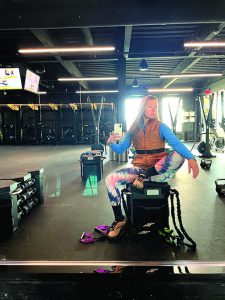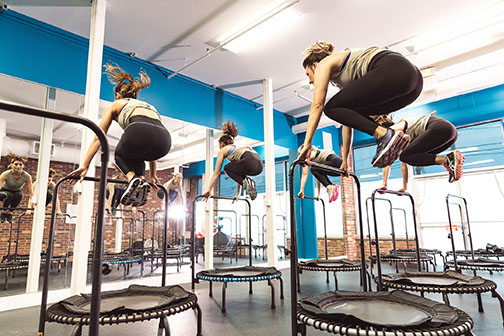By Jamie Jablonowski, MPH, BSN, RN, CIC, CPH

As the new year begins, so do people’s resolutions to improve their health. For many, this means making a commitment to increased physical activity and healthier living. The energy and motivation often feel strong as the new year begins, but then fade as the year progresses. Some individuals, however, do seem successful in their fitness journeys. What is the secret to their success? Do they have something others don’t or are there proven methods to create a long-lasting fitness routine?
With the excess of marketing and fitness ads this time of year, it can get confusing as to what healthy physical activity looks like. According to the Centers for Disease Control and Prevention (CDC), adults 18-64 years of age should get at least 150 minutes a week of moderate-intensity activity (e.g., brisk walking) and at least two days a week of activities that strengthen muscles. The recommendations for adults 65 years and older are the same with the addition of activities to improve balance, such as standing on one foot. The CDC reminds individuals that while these recommendations should be the goal, being as active as you are able is better than no activity at all.
Depending on your current activity level, these guidelines may seem quite daunting. Over half of Americans have trouble meeting these goals. According to data from the National Health Interview Survey in 2020, only 46.9 percent of adults ages 18 and older met the Physical Activity Guidelines for aerobic physical activity, and only 24.2 percent of adults ages 18 and older met the Physical Activity Guidelines for both aerobic and muscle-strengthening activity. This is a common pattern, and most gym owners and trainers recommend starting slow.
Ashley Bissett owns AB Fitness located in Monmouth Beach and Fair Haven. She started with a small studio in Sea Bright in 2013. In her experience, trying something new can be intimidating, but it’s important to be “doing something you really enjoy and setting realistic goals.” When getting started, she said, “Listening to your body, not going too fast and staying consistent is most important.”
Bissett encourages those new to an exercise program to work through the discomfort. “I find people, when they start, are a little intimidated. I tell them to give it at least three classes, try a few different things.” She also stresses not to feel defeated. “Everyone goes through it,” she said about starting a new exercise, but you will “feel a little more comfortable each day.” She adds that consistency is the most important factor in starting a new exercise regimen, and cautions individuals may not see progress for up to six months.
“There have been so many clients that have come in that have felt overwhelmed in the beginning and stayed consistent and have really turned themselves around,” Bissett said. “They come every day, they love it, they have changed their body and lost weight, but more importantly they have a great mindset. They enjoy the gym and themselves.”
Jenni Porter, a trainer and teacher at the Fort Athletic Club in Fort Monmouth, explained that the benefits of building a positive mindset in the gym can have a long-reaching effect on your day-to-day life. “Practicing the hard stuff in a community atmosphere, with a trainer, or even conquering things in the gym, I do believe strongly, makes things outside of the gym much easier. Success stories to me mean not only physical transformations, but the habits, discipline and decision-making all turn into a direct positive lifestyle.”

Porter added that individuals are motivated by different goals. “Some are driven by a desire to improve their overall health, increase energy levels, manage stress or are even looking for a community to be a part of. Others may be motivated by specific goals such as weight loss, muscle gain or enhanced athletic performance. The key is to tap into individual motivations, helping them connect with their personal goals and envision the positive impact physical activity can have on their lives.”
She echoed that consistency and community are also incredibly important in creating a sustainable lifestyle around physical activity.
Carley Dietrick of Oceanport has been working with Porter since March. She serves as the director of Outreach and Community Engagement at Seacrest Recovery Centers, working with those suffering from substance use disorder and mental health issues. “Caring for myself allows me to care for others,” Dietrick said. “I felt stuck in my routine and trying something new was a game changer. It was fun and the sense of community keeps me coming back.”
Katy Fraggos co-owns Perspirology in Sea Bright with her husband Jason Yachanin. Fraggos advised that, “For someone starting physical activity for the first time or after a long time, the best advice is to start slow and be consistent. Set a schedule that is feasible and sustainable to start. Two to three times per week of moderate exercise is excellent. As physical fitness improves, the schedule and intensity should also begin to shift.”
Fraggos noted any activity is great. “Physical activity is anything that gets you moving. You don’t even need to join a gym or fancy program to get started. Take a walk, take the stairs instead of the elevator, park in a space at the back of the lot, just keep yourself moving!”
Physical activity has many health benefits, including improving brain health, weight management, improving sleep and helping reduce the risk of anxiety and depression. Maintaining a healthy level of physical activity can also help reduce the risk of many diseases, including heart diseases, stroke, type 2 diabetes, some cancers such as bladder, breast and colon, and may help you recover from infectious diseases more quickly. The CDC found that physical activity was associated with fewer COVID-19 hospitalizations and deaths. They also found that adults who met the physical activity guidelines were half as likely to die from flu and pneumonia.
Walking can be a great way to ease into improving your fitness. According to the American Heart Association, walking only 30 minutes each day can increase heart health, reduce body fat, strengthen bones and muscles and increase endurance. Walking is especially helpful for those who may be new to physical activity, are overweight, pregnant or elderly.
As we celebrate the new year, Porter reminds her clients to celebrate their progress, too, no matter how small. “Surround yourself with positive influences, whether it’s a supportive community, inspirational stories or uplifting music during workouts,” she said. “Remember, physical activity is a celebration of what your body can do, and every effort contributes to a healthier, more vibrant life.”
This article originally appeared in the January 4 – 10, 2024 print edition of The Two River Times.














